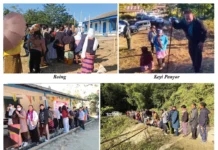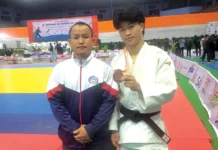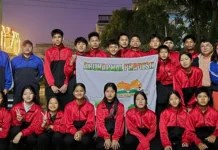TribalBookworms
[Dr Doyir Ete]
Miranda Pertin’s Beyond the Frozen Hills (2021) is a breath of fresh air in the literary landscape of our state. What stands out is its novel plot, the breathtaking landscape and its deep exploration of life – its ups and downs. The book philosophises to an extent, offering practical observations, yet not in a moralising way. It touches on a wide array of subjects, including love, family, nature, the environment, coexistence, motherhood, and much more. In an interview, the author acknowledged how the landscape of Tawang, its towering mountains, sprawling forests, and serene foothills was the inspiration for her story. These loom large in the narrative, much like Hardy’s Wessex dominates his novels. For those who have visited Tawang, the book vividly evokes its nature, transporting readers back to its beauty. The germ of the story begins in a quaint little village called Lhou, a few kilometres ahead of Tawang, during 2009–2010. The author writes that the inspiration for the story was from a local legend, where in a remote jungle, a corpse was once discovered with its head twisted 180 degrees, a feat impossible for human hands. Locals attributed this to the work of a Yeti or Gret-Pu (in the Monpa dialect). The author, who was posted in Tawang during this time, drew deeply from the place and its people and, in return, gave back to the place through her beautiful story.
Beliefs in the existence of mysterious creatures are deeply embedded in tribal folklore. In October of 2024, this daily featured an article titled ‘A Chilling Encounter with the Mythical Apa Mira’ by Prem T Loda, recounting an extraordinary incident from the remote Silla village in East Kameng. The story narrates how a man named Biro Langdo was viciously attacked by a creature called Apa Mira, a being often mentioned in Nyishi folklore. The marks on Biro’s body were unlike anything a human could inflict. How can one explain such encounters which defy logic and rationality? Yet, their inexplicability does not render them mere fiction or fabrications. In indigenous worldviews and cosmology, beings like Apa Mira are not regarded as fictional but are woven into the fabric of their belief systems. These traditions often challenge the boundaries of human understanding, evoking what Coleridge famously termed the “willing suspension of disbelief.” However, in such cases, the events go beyond mere suspension of our disbelief and rather become something more profound. Anthropologist Victor Turner describes how such encounters often occur in spaces where the boundaries between reality and imagination dissolve, eg, liminal spaces like forests, mountains, rivers, and during the twilight and at night. Similarly, philosopher Rudolf Otto describes such experiences as “numinous,” which refers to profound and mysterious confrontations with the “whole other” that evoke a mix of fear and fascination, pushing us beyond the ordinary. It is, therefore, unsurprising that Pertin’s novel is infused with fantastical elements, much like magical realism, particularly in its portrayal of the mystical world of Yur, and his home Yarchin, in the mountains of Lashike. Told in the first person, the story is a touching tale of two twins, Mavih and Zaraveeh, who lose their parents at an early age and are sent to live with their aunt, Mote Lobsang. The names are particularly striking: Mote, meaning ‘aunt’ in Adi, juxtaposed with Lobsang, a Monpa name. It symbolises the blending of cultures and identities — a recurring motif throughout the novel.
The narrative revolves around these three women and delves into themes of familial bonds, love, and self-fulfilment. Each woman embarks on her individual journey, both in the external world and within the interiority of her mind. They face adversity in their own unique ways. Mote Lobsang, with her steady heart and bold exterior, hides a softness within. She steps into the role of a mother for the orphaned twins, embodying resilience, beauty, and a capacity to rise above failures. Mavih, on the other hand, retreats into a world where words hold meaning only in silence, quietly fulfilling the duties assigned to her. Zaraveeh, the outspoken and fiery twin, balances strength and sensitivity as she learns valuable lessons through pain and tribulations. Together, these women are transgressive in their own ways – fiercely independent and level-headed. They are rebellious, epitomising inner strength and dignity.
The story explores different forms of love, weaving them into the lives of its characters. Mote Lobsang’s failed love with a Japanese man does not diminish her faith in love; instead, she demonstrates how empowerment and happiness can be found through other means as a mother, an aunt and a caregiver. Mavih offers love through her silent yet steadfast companionship, embodying quiet devotion. She, too, represents the multifaceted nature of love. She is a sister, an aunt, a healer, and a lover. Zaraveeh, in contrast, experiences love in all its complexities and forms. Zaraveeh’s journey, including her time as a student at Dera Natung Government College and Rajiv Gandhi University, makes her story deeply relatable to young readers. Her live-in relationship with Durong, a charismatic and ambitious student leader, captures the highs and lows of youthful romance. Initially passionate and driven, Durong becomes consumed by student politics and personal ambition, eventually taking Zaraveeh for granted. Their once-intense romance spirals into violence and abuse, forcing Zaraveeh to make the difficult decision to escape. This harrowing experience exposes her to the pain and challenges of the world. With the solace of her family and the healing presence of nature, Zaraveeh learns to face life with newfound resilience and stoicism. Durong, portrayed as a weak and insecure individual, is a relatable character. His story demonstrates the dark side of student politics and personal ambition. Set against the urban landscapes of Naharlagun and Itanagar, this part of the novel feels familiar through its vivid and associative depictions.
The Yur, a Yeti-like beast, is a towering figure in the story, described with a sensual allure both captivating and haunting. His presence symbolises the duality of nature — caring and tender, yet wild and brutal. He embodies a raw, animalistic power that is both appealing, and dangerous. While the first half of the novel dwells in the human world with its joys and sorrow, the second half depicts an alternate realm which is elemental and otherworldly while offering refuge and solace to those who seek it. It is a place where every aspect of existence is laid bare and stark in contrast with the complexities and pretences of humanity. Zaraveeh, the younger of the twin sisters, becomes enraptured by the Yur after he almost kidnaps her. Her growing love for him is not just for his imposing physique but also for his care, gentleness and patience. However, Zaraveeh is perturbed when she realises that the Yur had known her feelings all along, as if her emotions were like an open book to him. This initial sense of betrayal gives way to understanding when she comes to accept that honesty and transparency are intrinsic to the Yur and his kind. They are beings who do not hide their truths; they exist as they are, unfiltered and authentic. Yet, interestingly, this seemingly utopian world is also far from perfect. It has its own harsh rules. For instance, if an ‘ahahninsey’ (human in the Yur language), bears a Yur’s child, she must either be killed or returned to the human world. Moreover, Yur will lose all memory of her, their love, and their life together. Zaraveeh and Yur’s love defies societal expectations. She pursues happiness on her terms. The novel treats love with realism, exploring how placing it on a high pedestal sometimes leads to heartbreak and disillusionment. Mavih’s character develops more fully toward the end of the novel, and the potential within her character leaves readers intrigued. By leaving the story open-ended, the author teases at the possibility of a sequel that could explore Mavih’s journey in greater depth.
As a debut novel, this is a must-read. The maturity of the author’s voice shines through the pages with an original plot that is both engaging and enjoyable. The landscape is refreshingly vivid, adding depth to the story. However, the narration could have been enriched more from a more nuanced exploration of the interior landscape of the characters’ minds, adding more complexity to their emotional landscapes. Also, some of the phrasing sometimes sounds cliched, and a subtle shift and more innovation in this regard can truly add to the prose. Miranda Pertin is undoubtedly an emerging fresh voice in contemporary Arunachali literature — one to look out for. (Dr Doyir Ete is Associate Professor, Dept of English, RGU. She is also a member of the APLS and Din Din Club.)




